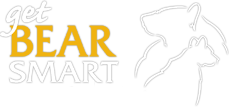Effective Bear Smart Bylaws and Ordinances
Background
Bylaws reflect a community’s overall principles and values and are meant to evolve as the community’s standards and norms shift. Community bylaws are governed by law and serve as educational tools that assist community members with understanding why a specific bylaw, such as a wildlife attractant bylaw, is required and what each community members role and responsibility is in relation to managing wildlife attractants.
Creating a wildlife attractant bylaw facilitates minimizing, to the greatest extent possible, the availability of human-generated foods and other substances that can often lead to the attraction of wildlife into human populated areas. These bylaws support communities with being porous to wildlife activity; allowing wildlife the ability to move through the landscape without the risk of them stopping, staying and potentially raising safety concerns for both humans and themselves.
It is important to understand that while the management of wildlife is a provincial or state responsibility, the regulation and management of wildlife attractants that bring wildlife into communities is the responsibility of local government.
Currently, wildlife is being killed in direct relation to being fed, whether intentionally or unintentionally. The onus is on local governments to not only educate residents and visitors on how to manage wildlife attractants, but to also adopt bylaws that clearly address the management of these wildlife attractants.
For an example of a wildlife attractant bylaw, view and download: Bylaw Toolkit.
Enforcement
Enforcement staff efforts typically focus priority on seeking voluntary bylaw compliance through educational efforts; it is preferable to have offenders correct their own behaviours voluntarily based on a better understanding of the bylaw and its purpose. Having a comprehensive and fair bylaw provides the necessary enforcement teeth should education not be sufficient to gain compliance. Bylaws are a necessary element to any successful human-wildlife management plan that addresses prohibiting the supply of unnatural foods to wildlife as a result of intent, neglect or irresponsible management of wildlife attractants.
Importantly, local government elected officials, councils and boards can direct enforcement staff to prioritize specific bylaws and can also provide direction on the enforcement process e.g., when to provide more tickets than warnings and vice versa. It is within a local government’s authority to place a higher priority on the enforcement of a wildlife attractant bylaw to reduce, and potentially eliminate, the needless and preventable human-caused loss of local wildlife and to reduce the potential for human injury, injury to pets/livestock, agricultural losses, or property damage.
Bylaws and ordinances should be tailored to address each community’s differing and particular needs. A stand-alone wildlife attractant bylaw can be adopted or alternatively, specific wildlife attractant management criteria can be inserted into an existing bylaw such as a solid waste bylaw.
Passing and enforcing bylaws is an important component of an effective regulatory system. It is also essential to help people understand what the rules are, why they exist, and how they can easily be complied with. A public education outreach program will assist with supporting residents and visitors to properly manage wildlife attractants and is key to a successful and long-term approach to mitigating negative human-wildlife interactions.
B.C. Bear Smart Program
The B.C. Ministry of Environment and Climate Change Strategy administers the Bear Smart Program that communities can voluntarily undertake. This program is a proactive, conservation strategy that outlines the necessary steps a local government can take to reduce the potential for human interactions with bears/wildlife. The Bear Smart Program contains six criteria for a community to pursue to reduce the potential for such interactions:
- Prepare a bear hazard assessment. Review the history and pattern of human-bear interactions in the community and identify high use bear habitat, human-use areas (school yards, playgrounds, etc.) and non-natural attractants such as accessible garbage, kitchen organics, fruit trees, bird feeders, livestock, bees, chickens, backyard compost, etc.
- Prepare a human-bear management plan. Develop strategies to resolve the hazards identified in Step 1 and reduce the potential for human-bear interactions.
- Revise planning and decision-making documents. Ensure the community’s commitment to the Bear Smart Community Program by incorporating Bear Smart practices into official community documents such as the Official Community Plan, Special Events Plan, Landscaping Plan and/or Solid Waste Management Plans.
- Implement a continuing education and outreach program. Education is a key component of human-bear interaction reduction, and the community must have an ongoing education program that is directed at all sectors of the community and consistent with the WildSafeBC/Ministry standard.
- Develop and maintain a bear-proof waste management system. Ensure that all components of municipal waste management including waste, recycling and composting are managed appropriately and made inaccessible to bears. This may be accomplished through bylaws, the use of bear-resistant containers, bear-proof enclosures and/or electric fencing.
- Implement Bear Smart bylaws that prohibit the provision of food to bears because of intent, neglect, or irresponsible management of attractants. Implement a compliance strategy for these bylaws to ensure that there is full compliance with them.
More information on the Bear Smart Program can be found here.
Provincial or State Regulations
Various provinces and states have existing regulations or laws that may compliment or enhance a community’s bylaws or ordinances.
In the Province of British Columbia, it is an offence to feed dangerous wildlife e.g., bears, cougars, coyotes, and wolves, or to disobey orders to remove and clean up food, food waste, or other substances that can attract dangerous wildlife. Refer to B.C.’s Wildlife Act Sections 33.1, 88.1, 84, 84.1 for more information.
In the State of New Jersey, 2013 New Jersey Revised Statutes, intentional feeding or otherwise attracting black bears is prohibited. Under Colorado state law (1992) it is illegal to feed big game animals e.g., bears, bighorn sheep, cougars, deer, elk, mountain goats and pronghorn Colorado Parks and Wildlife.
